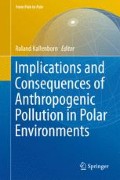Abstract
The world is facing large environmental threats such as climate changes and spread of contaminants. Environmental awareness has become a part of our daily lives. In order to engage youth in environmental issues and ignite their interest for natural sciences, a scientifically based project was run where pupils participated in environmental research on dioxins in fish. Dioxins and dioxin-like PCBs were screened by the use of BDS DR CALUX® bioassay in 203 fish samples from 13 countries: Australia, Croatia, the Czech Republic, Denmark, Estonia, Finland, France, Iceland, Latvia, Liechtenstein, Norway, Poland and Sweden. The project was part of the Norwegian education and outreach initiative of the International Polar Year (IPY), and schools were invited to participate. Pupils from 54 schools followed a scientific protocol for fish sampling; they recorded and published important field and fish data through a Web interface and labelled, packed and shipped the samples for CALUX analysis. We conclude that collaboration between schools and research institutions was beneficial for both partners. The results showed that the majority of the fish samples had dioxin levels below the maximum limit set by the EU commission. These results would be difficult to obtain without the effort of the involved schools.
Access this chapter
Tax calculation will be finalised at checkout
Purchases are for personal use only
Notes
- 1.
- 2.
- 3.
- 4.
- 5.
References
Andresen MU, Høgmo N, Sandås A (2015) Learning from ESD-projects during the UN decade in Norway. In: Jucker J, Mathar R (eds) Schooling for sustainable development in Europe. Springer Scientfic Publishing, Dordrecht, pp 241–255
Baeyens W et al (2007) PCBs and PCDD/FS in fish and fish products and their impact on the human body burden in Belgium. Arch Environ Contam Toxicol 52:563–571
Borgå K, Fisk AT, Hargrave B, Hoekstra PF, Swackhamer D, Muir DC (2005) Bioaccumulation factors for PCBs revisited. Environ Sci Technol 39:4523–4532
Creilson JK, Pippin MR, Henderson BL, Ladd IH, Fishman J, Votápková D, Krpcová I (2008) Surface ozone measured at globe schools in the Czech Republic—a demonstration of the importance of student contribution to the larger science picture. Bull Amer Meteor Soc 89:505–514
Heimstad ES, Herzke D (2004) Arctic POPs. Scientific report. NILU, OR 74/2004
Heimstad ES, Herzke D, Endregard G, Hetland K (2003) Circumpolar investigation of brominated diphenyl ethers—connecting research and education. Organohalogen Comp 61:65–68
Hites RA, Foran JA, Carpenter DO, Hamilton MC, Knuth BA, Schwager SJ (2004) Global assessment of organic contaminants in farmed salmon. Science 303:226–229
Knain E, Kolstø SD (2011) Utforskende arbeidsmåter—en oversikt. In: Knain E, Kolstø SD (eds) Elever som forskere i naturfag. Universitetsforlaget, Oslo, pp: 13–55 (In Norwegian)
Murk AJ, Legler J, Denison MS, Giesy JP, van de Guchte C, Brouwer A (1996) Chemical-activated luciferase gene expression (CALUX): a novel in vitro bioassay for Ah receptor active compounds in sediments and pore water. Fundam Appl Toxicol 33:149–160
Nali C, Lorenzini G (2007) Air quality survey carried out by schoolchildren: an innovative tool for urban planning. Environ Monit Assess 131:201–210
Schoeters G, Goyvaerts MP, Ooms DL et al (2004) The evaluation of dioxin and dioxin-like contaminants in selected food samples obtained from the Belgian market: comparison of TEQ measurements obtained through the CALUX bioassay with congener specific chemical analyses. Chemosphere 54:1289–1297
Schwartz RS, Lederman NG, Crawford BA (2004) An explicit approach to bridging the gap between nature of science and scientific inquiry. Sci Educ 88(4):610–645
Van den Berg M, Birnbaum L, Bosveld AT, Brunström B, Cook P, Feeley M, Giesy JP, Hanberg A, Hasegawa R, Kennedy SW, Kubiak T, Larsen JC, van Leeuwen FX, Liem AK, Nolt C, Peterson RE, Poellinger L, Safe S, Schrenk D, Tillitt D, Tysklind M, Younes M, Waern F, Zacharewski T (1998) Toxic equivalency factors (TEFs) for PCBs, PCDDs, PCDFs for humans and wildlife. Environ Health Perspect 106:775–792
van Leeuwen SPJ, Leonards PEG, Traag WA, Hoogenboom LAP, de Boer J (2007) Polychlorinated dibenzo-p-dioxins, dibenzofurans and biphenyls in fish from the Netherlands: concentrations, profiles and comparison with DR CALUX® bioassay results. Anal Bioanal Chem 389:321–333
Acknowledgments
We would like to express our gratitude to all the enthusiastic teachers who have arranged fishing field trips and inspired their pupils to do scientific work, to pose their own questions and to formulate their own answers and conclusions. Finally, we will say to the pupils: “We are impressed over your enthusiasm and skills as real scientific researchers, and hope to work with you in the future!” We are grateful for the financial support from the Research Council of Norway, project 18218: “A global network of schools investigating environmental pollutants in fish from the Arctic and worldwide”. We are very grateful for the help by Therese H. Nøst with the graphics. Thanks also to an anonymous referee for constructive input.
Author information
Authors and Affiliations
Corresponding author
Editor information
Editors and Affiliations
Rights and permissions
Copyright information
© 2016 Springer-Verlag Berlin Heidelberg
About this chapter
Cite this chapter
Heimstad, E.S., Grønstøl, G., Hetland, K.T., Alarcon, J.M., Rylander, C., Mariussen, E. (2016). Schools Taking Part in a Research Project Investigating Dioxins in Fish. In: Kallenborn, R. (eds) Implications and Consequences of Anthropogenic Pollution in Polar Environments. From Pole to Pole. Springer, Berlin, Heidelberg. https://doi.org/10.1007/978-3-642-12315-3_6
Download citation
DOI: https://doi.org/10.1007/978-3-642-12315-3_6
Published:
Publisher Name: Springer, Berlin, Heidelberg
Print ISBN: 978-3-642-12314-6
Online ISBN: 978-3-642-12315-3
eBook Packages: Earth and Environmental ScienceEarth and Environmental Science (R0)

